Ⅰ. Ideas You Should Know Before Cloning A Hard Drive
Cloning a hard drive often happens when users want to upgrade their hard disk or want to make a full backup of important data. Whatever the reason, the cloning hard drive action means making an exact copy of the source disk to the target disk. Wait! Since copying can also create an exact copy to the target disk, what is the difference between cloning and copying?
Clone vs Copy
Clone: When you clone a hard drive, you're not only copying the files and data to the target disk but also the partition layout, operating system (if there had any), files, downloads, programs, and settings.
Copy: When you copy a hard drive, you just get a new hard drive with replicas of all the visible files.
Another scene is when you only need to transfer or backup files from one drive to another, you definitely want to choose a faster method. Then how can you move files faster? Is cloning a drive faster than copying? The answer is as follows.
In general, copying is faster than cloning because cloning a hard drive reads and writes every block on the drive, even the empty ones, whereas copying only reads and writes the data.
However, if you're planning to make a copy of an HDD with lots of fragmented files, which means files in this HDD have been deleted or modified over a period of days, cloning it would be a better choice. Copying a fragmented file may require a lot of physical seeking (i.e., moving the I/O head(s) to different locations on the disk). Thus, copying the files could take more time than copying the whole disk.
Clone vs Entire Machine Backup
People always get confused about clone and backup when these two terms are put together. Although clone and backup sound like two totally different things, they do have something in common:
- Both can make a full copy of data and operating system
- Both require an additional drive to save the source disk data
- Either a backup image or a cloned drive can be used for the purpose of recovery
Due to the above three features, it is hard for non-IT professionals to decide which method they want to use, clone a hard drive or make an entire backup. If you also don't know which one you really need, we list a few tips here to help you make the decision.
- 1. Cloning makes two identical hard drives, while backup saves all selected files as an image file (e.g: a .pbd file) to another drive.
- 2. Clone copies everything, including the disk layout, on the hard drive, but backup only copies content like files or operating system.
- 3. Clone must require a physical & empty hard drive bigger than the used space of the source drive, while a backup image file is much smaller, and you can save it to a local drive, network drive, NAS, or cloud.
- 4. A cloned hard drive with an operating system is bootable, but you can only use a system backup image by performing recovery.
- 5. Clone is a one-time behavior, and backup is continuous.
LEARN MORE
For more information about the definition and difference between clone and backup, you could refer to this page: Disk Clone vs. Entire Machine Backup
Ⅱ. Clone Procedure 1: Connect the Secondary Drive to Your Computer
The first step of cloning a hard drive is connecting both the source and target disk to one computer. As to the types of hard drives, there are HDD and SSD. Under the types of SSDs, you could see SATA SSD, M.2 SSD, and NVMe SSD available on the market. Different kinds of hard drives have different connection methods. In this part, we'll cover all the possibilities and tell you how to connect the new hard drive to your computer before the hard drive cloning process.
1. Connect HDD to Your Computer
*If you're using a laptop, you could skip this part. Because most of the HDDs are used on desktops, there's not enough space for laptops to install an HDD.
Here are the tools you will use to connect the HDD: A power cable, a SATA cable, and a screwdriver to open your case. Make sure you have all these items, and then follow the guide to install HDD on your computer.
Step 1. Turn off your computer, remove all the cables from the back, and open your computer case using the screwdriver. The tray might have to be removed and reattached with a screwdriver.
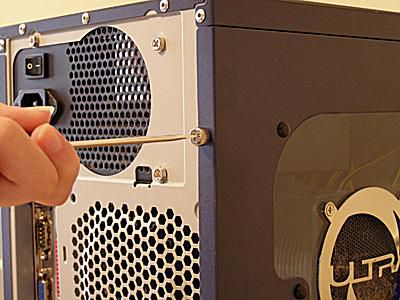
Step 2. Put the hard drive into the tray and make sure the inputs are facing the right way.
Step 3. Connect the power cable and the SATA cable to the hard drive. This should be very easy, just find the corresponding connectors.
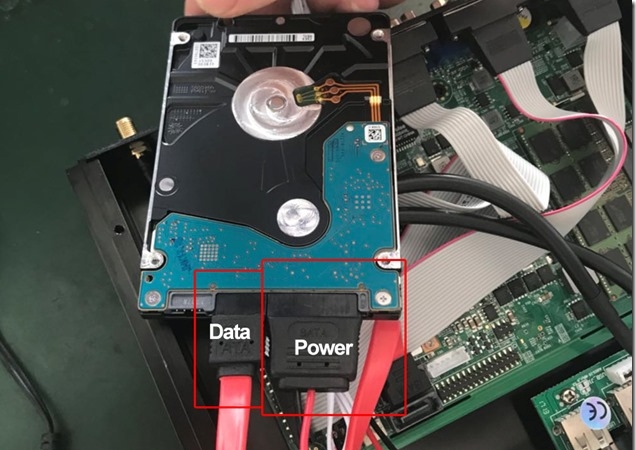
Step 4. Once the cables are connected, slide your hard drive back into the slot on the tray.
Step 5. Next, you should route the power and the SATA cable into your case and route it through to the port.
Step 6. Now you can close the case and get ready with the cloning process.
2. Connect SSD to Your Computer
As a younger hard drive, SSD outperforms HDD in the aspect of speed and durability. Unlike HDD, different SSDs have different connectors, mainly divided into SATA and M.2. SSDs can apply to both laptops and desktops. Here, we will introduce how to connect an SSD to a desktop and laptop separately.
What's the Difference: NVMe vs SSD?
In recent years, a newly raised hard drive called NVMe SSD seems to be a strong competitor of SSD. What's the difference between these two kinds of hard drives, and in what ways do NVMe hard drives outperform SSDs? In this article, we will thoroughly introduce NVMe SSD and common SSD and help you make the decision.
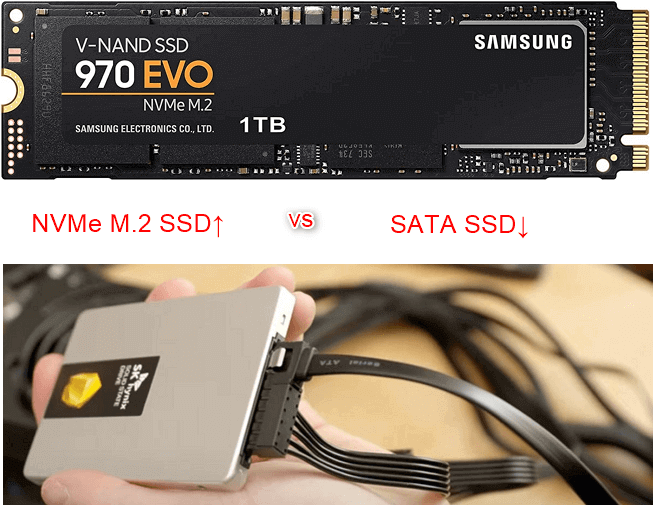
On desktop:
Step 1. The preparation for connecting SSD is the same as that of connecting HDD. You need the power cable, SATA cable, and a screwdriver.
Step 2. Turn off your computer, remove all the cables from the back, and open your computer case with the screwdriver. Find the old hard drive in your case, and you might likely find another drive bay nearby.
Step 3. Slide your SSD into place with the SATA power connector facing outwards, where you can access them and line up the holes to screw securely into place.
Step 4. There should be an unused power cable inside the computer. Connect it to the SSD.

Step 5. Connect the SATA cable from the motherboard to the SSD. If you can't find the SATA connection, follow the SATA cable of your old hard drive, you might find another one available.
Step 6. Then close your computer case with the screwdriver, and connect all removed cables back. The installation process is done.
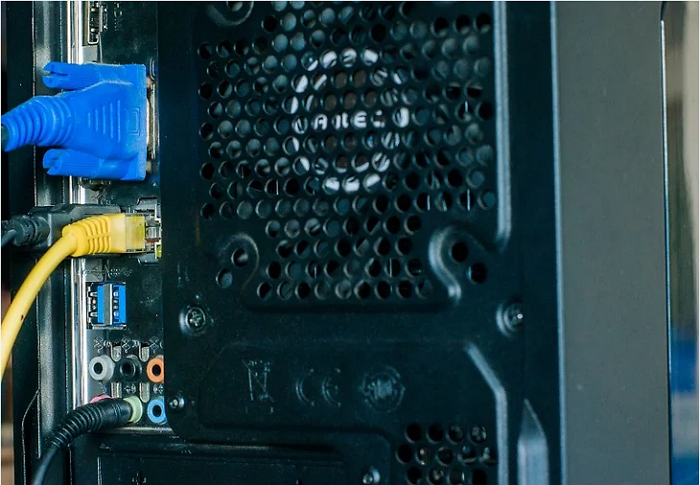
On laptop:
Because in a laptop there is not enough space for users to install two SSDs, so generally, you need a USB adapter to connect SSD to your laptop. Now nearly all laptops are using NVMe SSD as the storage device, which has an M.2 connector, so if you're cloning the hard drive to replace the old one, you should buy an adapter that has an M.2 port.
Step 1. Connect the USB adapter to your laptop. For your information, if the SSD you're going to clone is a SATA SSD, you should buy a SATA adapter; if the SSD you're going to clone is an NVMe SSD, you should buy an NVMe adapter.
Step 2. Find the connector on your SSD, and directly connect it to the adapter.
Step 3. Then you can start the cloning process.
Note: The USB adapter is only for cloning a hard drive. In this case, you need to connect both hard drives to your laptop. But if you want to replace the old hard drive with the cloned one, you still need to open your laptop case with a screwdriver and put the new SSD in it.
Ⅲ. Clone Procedure 2: Choose the Best Hard Drive Cloning Software
After connecting hard drives to the computer, you should get ready to start the cloning process. There is no built-in cloning utility in Windows. Although it is possible to clone a hard drive manually, it is much easier and faster to use cloning software. Some cloning software also offers additional features, such as the ability to resize partitions and compress data. When choosing cloning software, it's important to choose a product that is compatible with your operating system and that offers the features you need.
We have compared 5 hard drive cloning software in the aspects of price, ease of use, additional features, and overall experience. Take a glimpse of the comparison chart and it might help you make the best decision.
|
Comparison |
Price (Yearly) | Ease of Use | Additional Features | Overall Experience |
| #1. EaseUS Disk Copy | $39.90 | ★★★★★ | ★★★ | ★★★★★ |
| #2. Acronis Cyber Protect Home Office | $49.99 | ★★★★ | ★★★ | ★★★★ |
| #3. Paragon Hard Disk Manager | $79.95 | ★★★ | ★★★★★ | ★★★ |
| #4. Clonezilla | Open Source | ★★ | ★ | ★★ |
LEARN MORE
In order to choose the best cloning software, it is better to read the software review carefully. Click here to learn about how exactly every hard drive cloning software performs.
Ⅳ. Clone Procedure 3: How to Clone a Hard Drive From HDD to SSD
Now you've got the two hard drives connected and got disk cloning software, it's time to execute the cloning process. When cloning a hard drive, mostly from HDD to SSD, there are five procedures you should perform to complete the cloning. But don't worry if it's too cumbersome, follow the guide below and you'll find it clear and easy.
#1. Initialize the Hard Drive
If your hard drive is a brand-new one, your computer couldn't detect it unless you have it initialized. So first of all, follow the steps below to check how to initialize a hard drive.
Step 1. Right-click the Start button and select Disk Management.
Step 2. In the Disk Management window, you could see there are two disks. Right-click the hard drive you want to initialize, and then click "Initialize Disk". If the disk is listed as Offline, first right-click it and select Online.
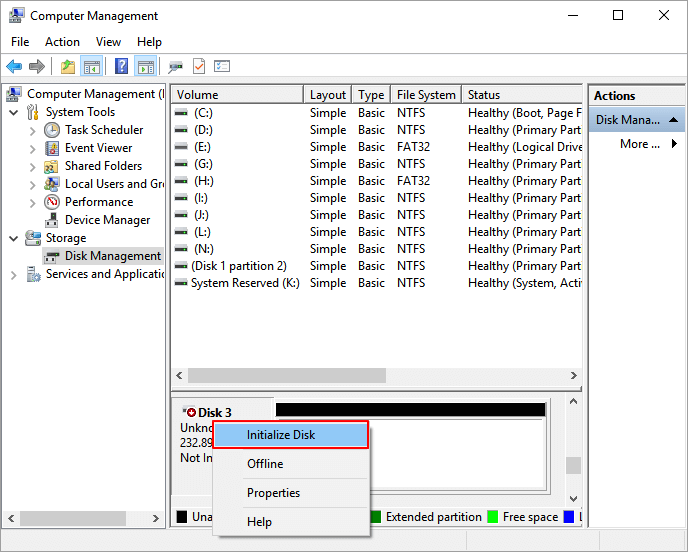
Step 3. Then you should choose the partition style of your new hard drive. There are two options: MBR or GPT. They are two popular partitions styles on Windows-based computers. MBR is short for Master Boot Record and GPT stands for GUID Partition Table. Which partition style you choose has a lot to do with whether your computer is BIOS-booted or UEFI-booted. The BIOS+MBR mode or UEFI+GPT mode is commonly used nowadays.
For Users Who Want to Clone from MBR to GPT or Vice Versa:

You should notice that if you're planning to boot from the cloned hard drive, you should keep the partition style of your old and new hard drives the same. Otherwise, you might have a problem booting your computer from the new hard drive. For example, if your old hard drive is an MBR, even you can clone the data and disk layout to a GPT disk. You can't boot from the GPT disk as the computer is still BIOS-booted.
#2. Start Cloning with EaseUS Disk Copy
Now, both the two hard drives are detectable. Here we take EaseUS Disk Copy as an example to show you how to start cloning.
EaseUS disk cloning software provides you with two kinds of clone models: disk/partition clone and sector-by-sector clone. The main difference between those two clones is the system clone will automatically select the system partition and disk so that users don't need to select them on their own.
Before cloning:
- If your computer has only one slot, connect the target disk to your machine via a USB-to-SATA/NVMe adapter.
- If your computer has an extra slot, install the target disk into the empty slot properly, and make sure it is compatible.
Step 1. Launch EaseUS Disk Copy and choose Disk Mode.
Install EaseUS Disk Copy cloning software on your Windows computer, then launch it and select Disk Mode from the left panel.
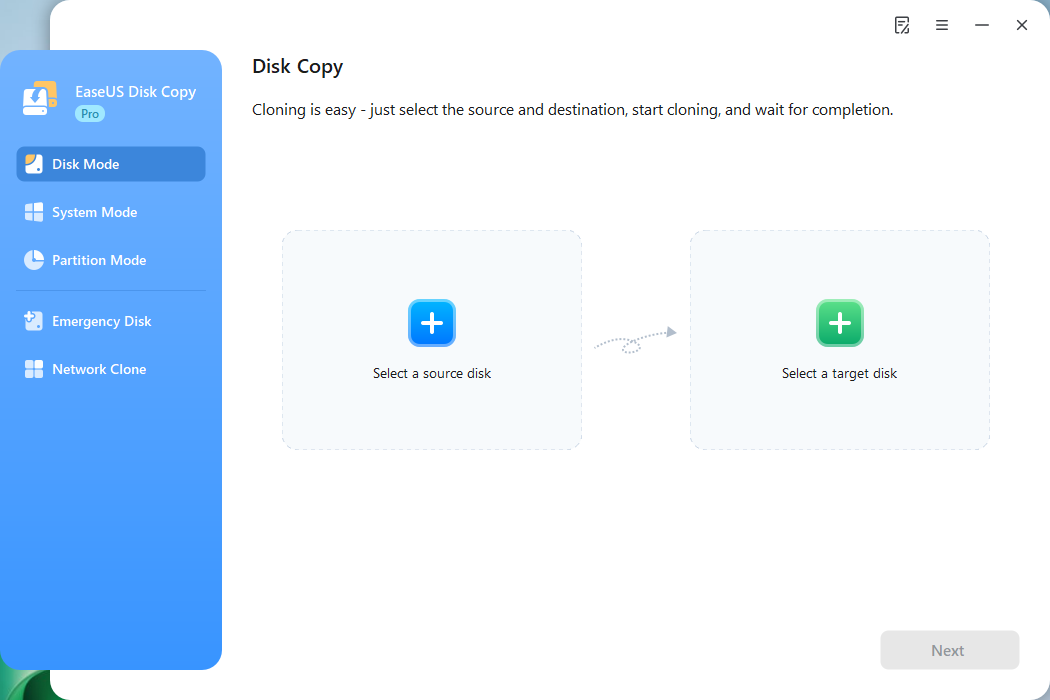
Step 2. Select the source drive.
Select the drive you want to copy, then click Select.
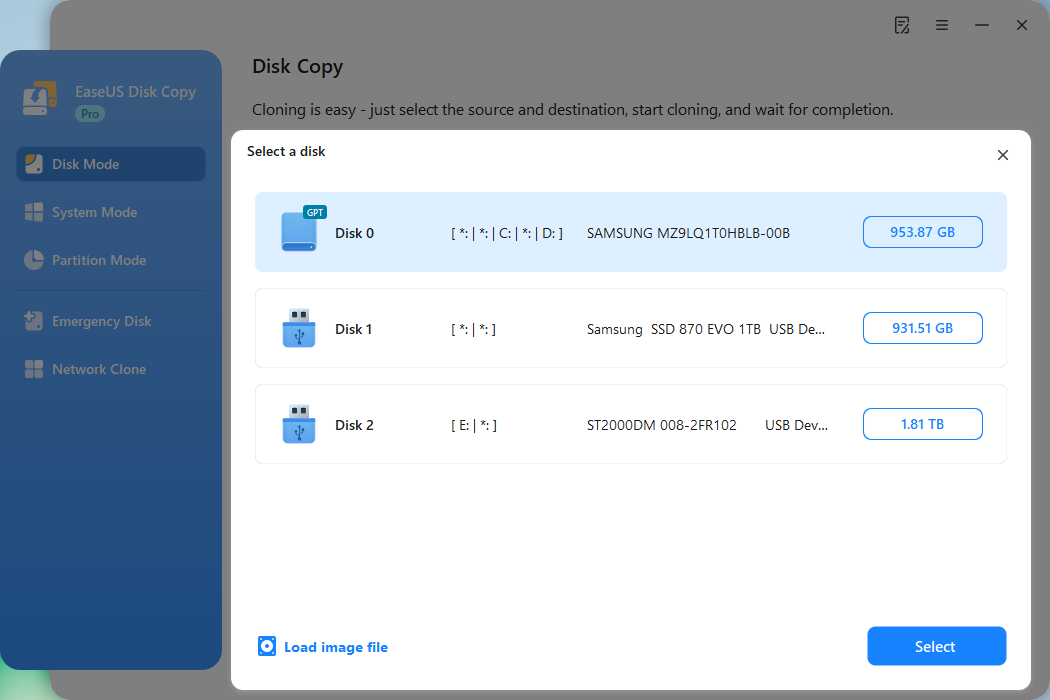
Step 3. Choose the target disk.
Choose the disk that you want to clone data to, and click Select. Note that the used space of the source disk should be less than the target disk capacity.
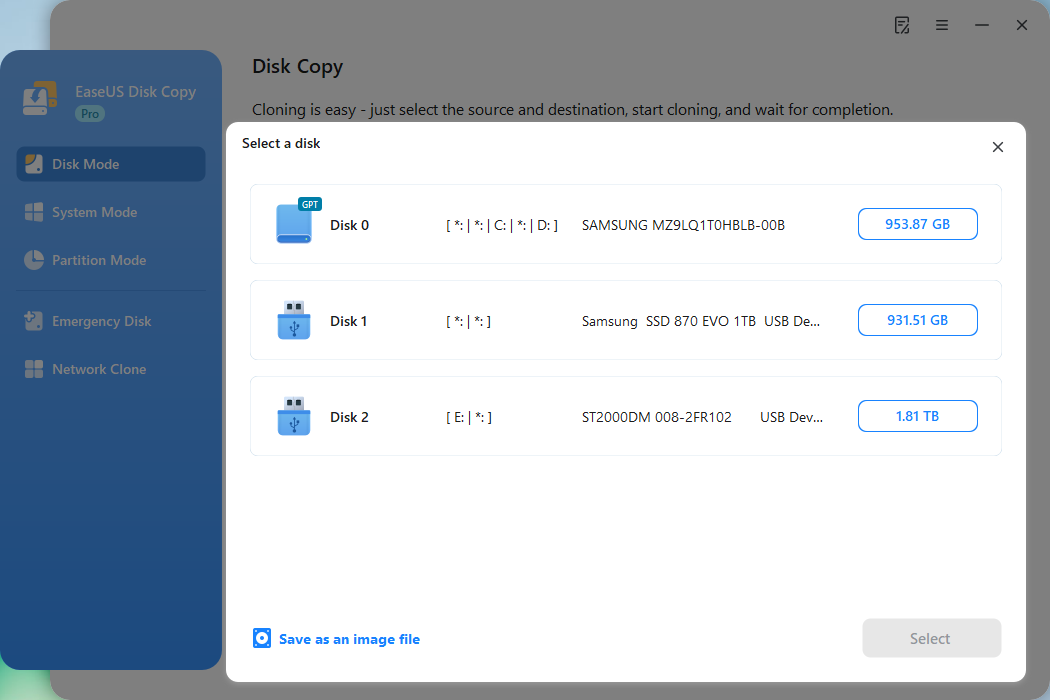
*At this step, you can also click the option "Save as an image file" to store your disk as a compressed image file, which can be restored without any data loss.
Step 4. Adjust disk layout.
Specify the target disk layout as your preference. You can choose among:
- Autofit the disk: makes some changes by default on the destination disk layout so that it can work at its best.
- Copy as the source: create a 1-to-1 copy of your source disk; the layout is the same as the source disk.
- Edit disk layout: allows you to manually resize/move the partition layout on this destination disk.
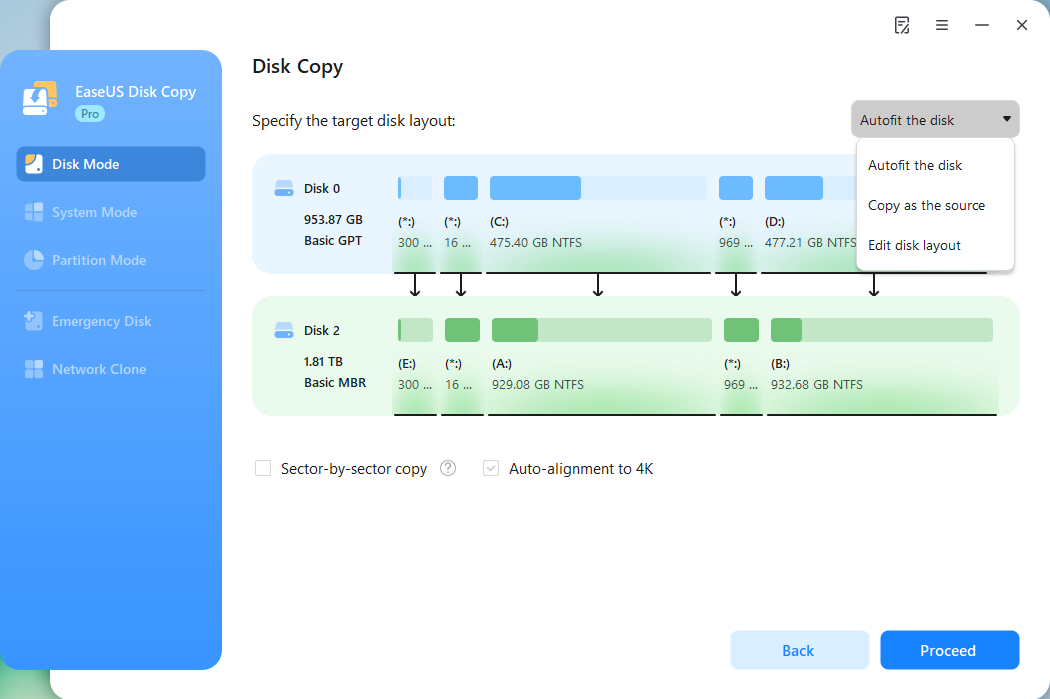
*If the target disk is an SSD, the option "Auto-alignment to 4K" will be checked automatically to optimize the performance of your SSD.
Step 5. Start cloning.
Click Proceed, and a message will appear, warning you that data will be lost. Confirm the message by clicking Continue.
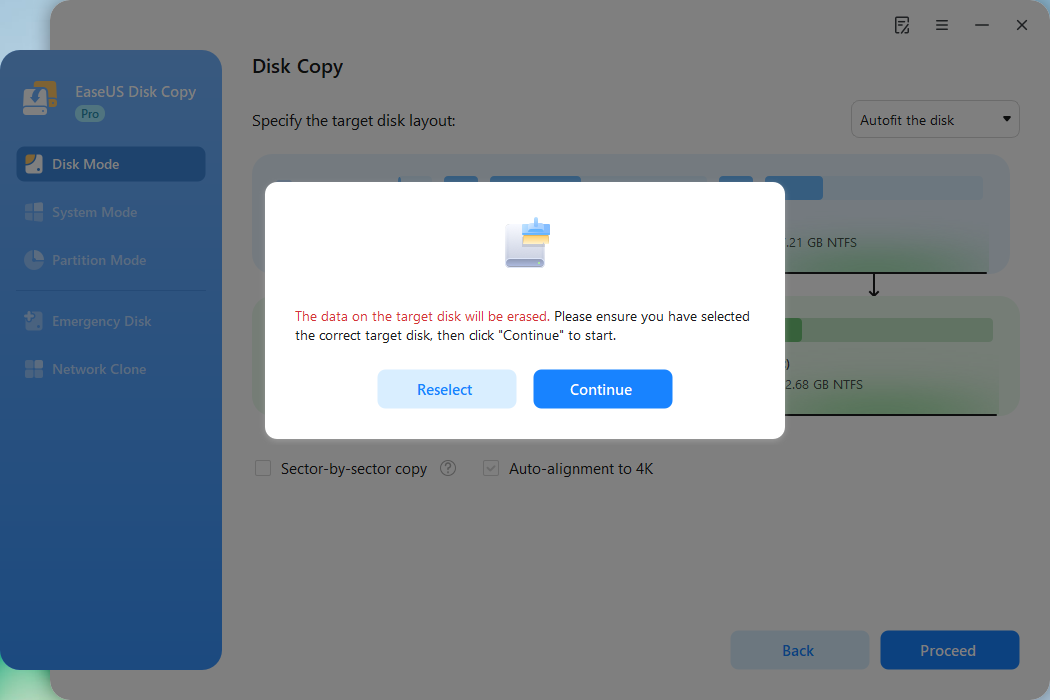
Now, it will start executing the cloning task.
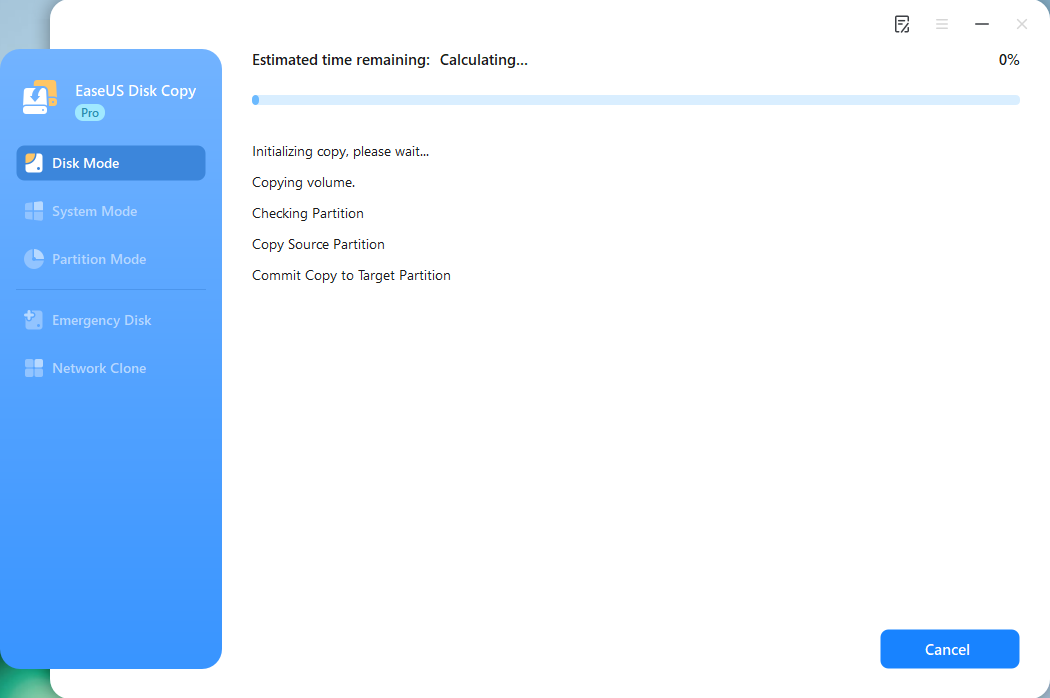
*The time it takes to clone a hard drive depends on how much data is on the source disk, and it will also be affected by the disk types, USB connection, etc.
#5. Boot from the Cloned Hard Drive
This process makes sense when you perform a system clone. No matter whether you want to keep both disks or only keep the new disk, you could follow the guide to boot from the cloned hard drive.
Case 1. If you want to keep both the old disk and the new disk
- Restart the PC and press F2 (F8, F10, DEL...) to enter BIOS settings.
- In the Boot option, select new HDD/SSD as the new boot drive.
- Exit BIOS and restart the computer.
Case 2. If you want to only keep the new disk
- Unplug the old disk and make sure the new disk is well connected.
- Connect the new disk and make sure it can be detected by the computer.
- Restart your computer.
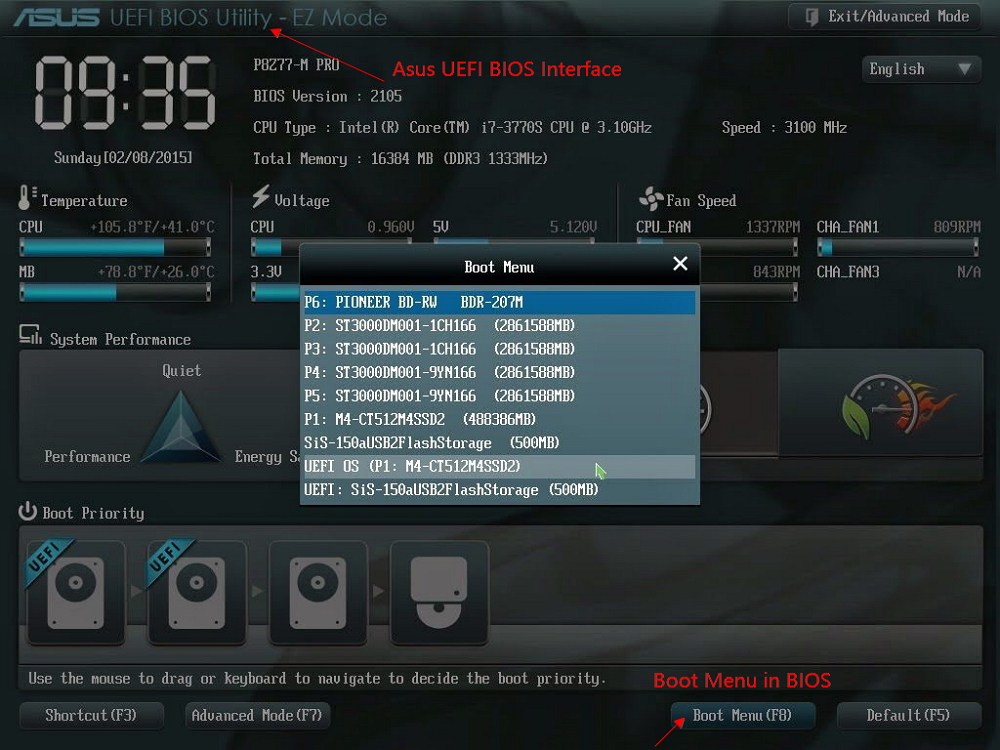
LEARN MORE
The above guide is about how to clone an HDD to SSD. If you are curious about the whole preparation of cloning a hard drive to SSD, click here to learn about it. How to Clone HDD to SSD
Ⅴ. Clone Procedure 4: Clone From SSD to HDD (New Disk to Traditional Disk)
Comparing SSDs to HDDs, the former doesn't outperform the latter in every way. HDD charges less with a larger capacity, so there are still many users who prefer to use HDD as the boot drive. Other than this reason, there are other three reasons why users would want to clone from SSD to HDD.
Reasons to Clone from SSD to HDD:
- Upgrade to a larger HDD: When the SSD is full, upgrade it to a larger one with the lowest cost, a traditional HDD is a great option.
- Replace a failed or damaged SSD: When the SSD is corrupted or damaged and you can't access any data on it, you may clone it to an external HDD for data recovery.
- Completely erasing SSD before selling away: If you're planning on selling your computer, cloning the SSD data to an HDD and then wiping it will ensure that your data is safe
Although the purposes are different, you can actually use the same method and tool to start cloning. Refer to this page to see how to clone SSD to HDD.
Ⅵ. Can You Clone A Hard Drive To New Computer
Other than upgrading a disk from old to new, what else can you think of when it comes to cloning a hard drive? Have no idea? Let me tell you when you buy a new computer. If you're planning to buy a new computer to replace the old one, you should think about cloning the hard drive to the new computer. Why? Let me tell you the reason.
Your old computer has everything you need and everything you are used to, like the game you've been playing for years, folders that saved all your work files, or the system that contains all your personal files and configure files through all these years. You want a new computer, with a better hard disk or a more advanced graphics card, but you don't want to lose everything else on the old computer. That's why we suggest you clone the old hard drive to the one on the new computer.
Q1. Can You Copy the OS to the New Computer?
Generally, when users want to move files to the new computer, they think about the OS first. The system files contain system configuration, data, programs, and settings, which all cannot be synced or transferred through cloud service. So if you wonder can you transfer the OS to the new computer? Great news, you can!
Q2. How to Clone a Hard Drive to the New Computer?
There is an effective way to clone a hard drive to the new computer: create a system image first, and then restore it to your new computer. With this method, you could build a new computer without spending too much time and can save the original system settings. If you prefer the Windows built-in tool, use the Backup and Restore (Windows 7) to create a system image. Third-party software like EaseUS Disk Copy also provides an easier way to clone a hard drive to the new computer.
LEARN MORE
The process of building a new computer is complicated and tedious, but you don't need to worry if only you check the How to Move/Clone Windows 10 Hard Drive to A New Computer guide.
Ⅶ. How to Clone Hard Drive on Mac
Updating SSD for Mac is as essential as that for Windows. No matter whether you want to speed up your Mac's performance or you want to replace a corrupted hard drive, cloning the hard drive is the best way to satisfy the needs of keeping the data and replacing the disk. Mac's in-built feature Disk Utility is powerful enough for users to clone the hard drive. Follow the steps in this part and try to clone a hard drive on Mac.
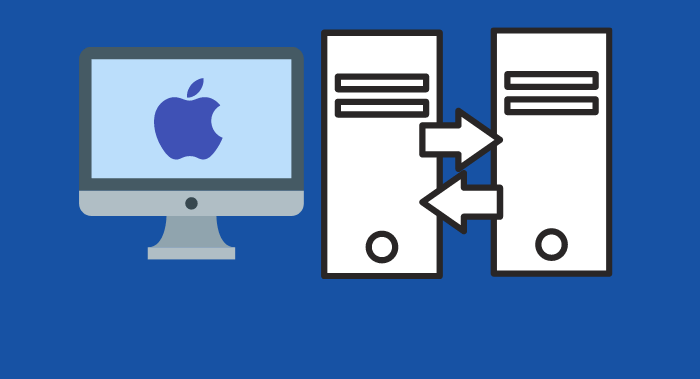
Step 1. Prepare the SSD for cloning
First, you need to buy an SSD that is compatible with your Mac. Make sure to get a drive that is the same size or larger than your current hard drive. Once you get your new SSD, connect it to your Mac using a USB cable or external case.
Next, open Disk Utility (located at /Applications/Utilities) > select your current hard drive from the left sidebar, then click the Erase tab > select the "Mac OS Extended (Journaled)" format and click the "Erase" button.
Step 2. Clone the source drive to the destination drive
Now that your current hard drive has been wiped, it's time to clone it to an SSD. Select the SSD from the left sidebar and click the Recovery tab.
Drag your current hard drive into the "Source" field and your SSD into the "Destination" field. Make sure the "Erase Destination" box is checked and click the "Recover" button.
Depending on the size of your hard drive, this process may take a while.
Step 3. Boot Mac from SSD after cloning
Once done, you can restart your Mac and hold down the Option key as it starts up. This will bring up a menu where you can choose which drive to boot from. Choose your new SSD and you're all set!
Ⅷ. Final Thought
So, you've followed our guide and you now know how to clone a hard drive. Congratulations! We hope you found it helpful. By taking the time to clone your hard drive, you're ensuring that all your important data is properly backed up in case of a disaster. So sit back, relax, and enjoy the peace of mind that comes with knowing your data is safe.
Was This Page Helpful?
Updated by Jerry
"I hope my articles can help solve your technical problems. If you are interested in other articles, you can check the articles at the bottom of this page, and you can also check my Facebook to get additional help."
Jean is recognized as one of the most professional writers in EaseUS. She has kept improving her writing skills over the past 10 years and helped millions of her readers solve their tech problems on PC, Mac, and iOS devices.
Related Articles
-
Create System Image: Complete Guide and Walkthrough in 2025
![author icon]() Jerry/Dec 01, 2025
Jerry/Dec 01, 2025 -
(2025) An Ultimate Guide to Backup Hard Drive and Restore Your Computer
![author icon]() Jean/Dec 01, 2025
Jean/Dec 01, 2025 -
Beginner's Guide: How to Use File History Windows 10
![author icon]() Jean/Dec 01, 2025
Jean/Dec 01, 2025 -
Overall Guide to Migrate/Move OS to SSD
![author icon]() Jean/Dec 01, 2025
Jean/Dec 01, 2025